inflation pressure BMW X5 3.0I 2006 E53 Owner's Manual
[x] Cancel search | Manufacturer: BMW, Model Year: 2006, Model line: X5 3.0I, Model: BMW X5 3.0I 2006 E53Pages: 202, PDF Size: 4.13 MB
Page 6 of 202
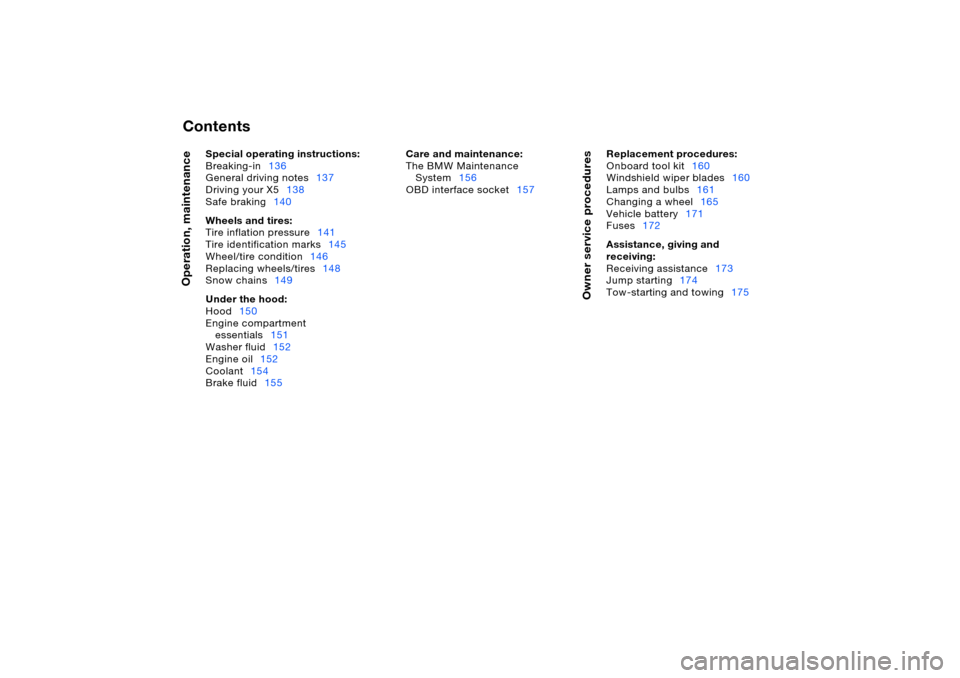
ContentsOperation, maintenance
Owner service procedures
Special operating instructions:
Breaking-in136
General driving notes137
Driving your X5138
Safe braking140
Wheels and tires:
Tire inflation pressure141
Tire identification marks145
Wheel/tire condition146
Replacing wheels/tires148
Snow chains149
Under the hood:
Hood150
Engine compartment
essentials151
Washer fluid152
Engine oil152
Coolant154
Brake fluid155Care and maintenance:
The BMW Maintenance
System156
OBD interface socket157Replacement procedures:
Onboard tool kit160
Windshield wiper blades160
Lamps and bulbs161
Changing a wheel165
Vehicle battery171
Fuses172
Assistance, giving and
receiving:
Receiving assistance173
Jump starting174
Tow-starting and towing175
Page 20 of 202

20n
Indicator and warning lamps
Transmission temperature
* +
The transmission is overheated.
Reduce speed immediately and
stop at a suitable location so that the
system can cool down again. Have the
system checked immediately.
Yellow: stop immediately
Flat Tire Monitor
+
An acoustic signal also sounds:
there is a flat tire or extensive
inflation pressure loss. Reduce speed
immediately for stopping while avoiding
extreme braking and steering maneu-
vers.
For additional information, refer to
page99
Red or yellow: continue to drive
cautiously
The red brake warning lamp
lights up together with the warn-
ing lamps for ABS and DSC/
xDrive. In addition, a warning
signal sounds:
ABS, DSC, HDC and xDrive
have failed. Drive may be being
exerted exclusively via the rear
axle. Have the system checked
as soon as possible.
For additional information, refer to
pages91, 92
Proceed cautiously and defen-
sively. When driving on poor
roads, avoid using full throttle or press-
ing the accelerator beyond the kick-
down point and also avoid forceful
braking or full braking. Otherwise, the
drive train may be damaged or acci-
dents can occur.<
If the brake warning lamp lights up in
yellow in the above-described combi-
nation, the EBV Electronic brake-force
distribution is still available.
Display of the previously
described malfunction in Cana-
dian models.
Page 98 of 202
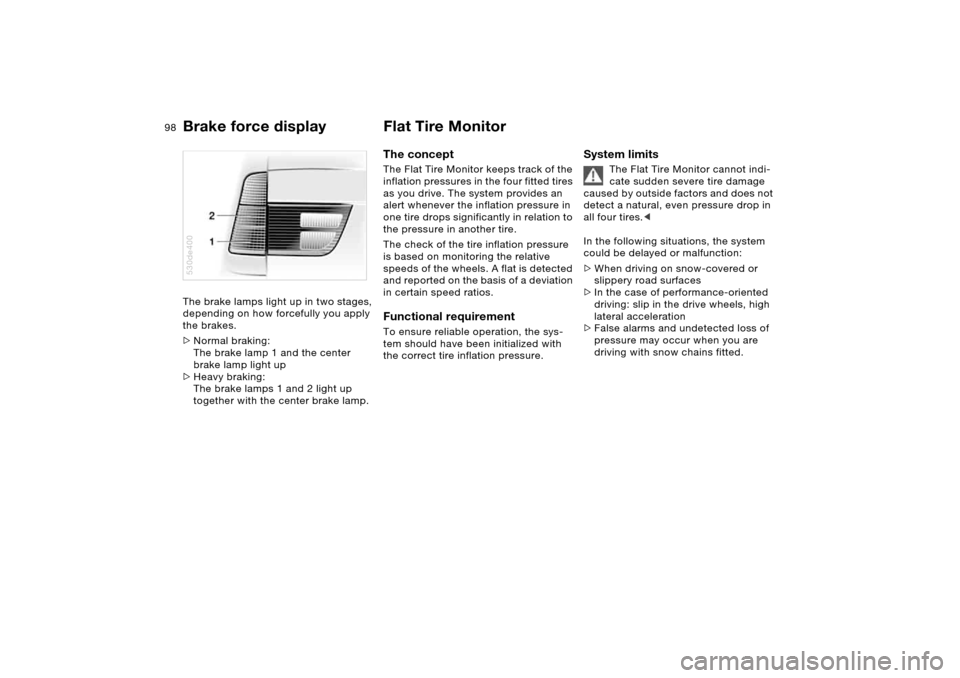
98n
Brake force display Flat Tire MonitorThe brake lamps light up in two stages,
depending on how forcefully you apply
the brakes.
>Normal braking:
The brake lamp 1 and the center
brake lamp light up
>Heavy braking:
The brake lamps 1 and 2 light up
together with the center brake lamp.530de400
The concept The Flat Tire Monitor keeps track of the
inflation pressures in the four fitted tires
as you drive. The system provides an
alert whenever the inflation pressure in
one tire drops significantly in relation to
the pressure in another tire.
The check of the tire inflation pressure
is based on monitoring the relative
speeds of the wheels. A flat is detected
and reported on the basis of a deviation
in certain speed ratios.Functional requirementTo ensure reliable operation, the sys-
tem should have been initialized with
the correct tire inflation pressure.
System limits
The Flat Tire Monitor cannot indi-
cate sudden severe tire damage
caused by outside factors and does not
detect a natural, even pressure drop in
all four tires.<
In the following situations, the system
could be delayed or malfunction:
>When driving on snow-covered or
slippery road surfaces
>In the case of performance-oriented
driving: slip in the drive wheels, high
lateral acceleration
>False alarms and undetected loss of
pressure may occur when you are
driving with snow chains fitted.
Page 99 of 202

99n
OverviewControlsMaintenanceRepairsDataIndex
Flat Tire MonitorInitializing system
Perform the initialization immedi-
ately every time you correct the
inflation pressure, change a tire or
change a wheel or all wheels. The vehi-
cle must be driven during initialization.<
1. Start the engine, but do not begin to
drive immediately.
2. Press the button until the yellow indi-
cator lamp in the instrument cluster
lights up for a few seconds.
3. Begin driving.
530de419
It takes a few minutes of driving before
the Flat Tire Monitor can detect and
report a flat tire.
When driving with snow chains,
do not initialize the system.<
Indication of a flat tire
The warning lamp lights up yel-
low. There is a flat tire or exten-
sive inflation pressure loss.
1. Reduce speed and stop the vehicle
carefully. Avoid sudden braking and
steering maneuvers
2. Identify damaged tire
If identification is not possible,
contact your BMW Sports
Activity Vehicle center.<
3. Replace the damaged wheel, refer to
Changing a wheel on page 165.
Page 141 of 202
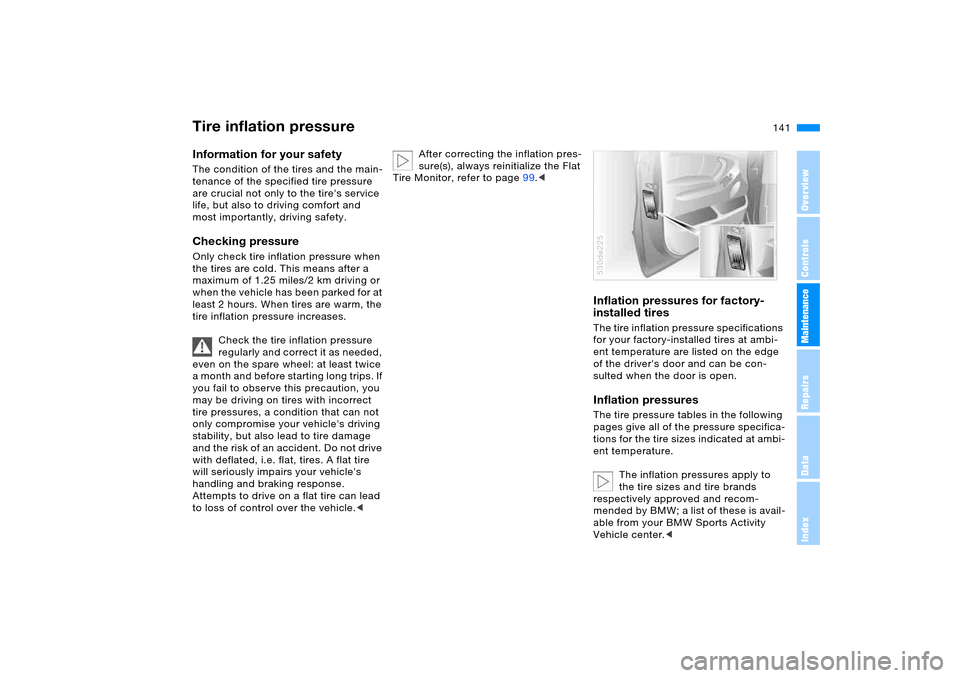
141n
OverviewControlsMaintenanceRepairsDataIndex
Information for your safety The condition of the tires and the main-
tenance of the specified tire pressure
are crucial not only to the tire's service
life, but also to driving comfort and
most importantly, driving safety. Checking pressureOnly check tire inflation pressure when
the tires are cold. This means after a
maximum of 1.25 miles/2 km driving or
when the vehicle has been parked for at
least 2 hours. When tires are warm, the
tire inflation pressure increases.
Check the tire inflation pressure
regularly and correct it as needed,
even on the spare wheel: at least twice
a month and before starting long trips. If
you fail to observe this precaution, you
may be driving on tires with incorrect
tire pressures, a condition that can not
only compromise your vehicle's driving
stability, but also lead to tire damage
and the risk of an accident. Do not drive
with deflated, i.e. flat, tires. A flat tire
will seriously impairs your vehicle's
handling and braking response.
Attempts to drive on a flat tire can lead
to loss of control over the vehicle.<
After correcting the inflation pres-
sure(s), always reinitialize the Flat
Tire Monitor, refer to page99.<
Inflation pressures for factory-
installed tiresThe tire inflation pressure specifications
for your factory-installed tires at ambi-
ent temperature are listed on the edge
of the driver's door and can be con-
sulted when the door is open.Inflation pressuresThe tire pressure tables in the following
pages give all of the pressure specifica-
tions for the tire sizes indicated at ambi-
ent temperature.
The inflation pressures apply to
the tire sizes and tire brands
respectively approved and recom-
mended by BMW; a list of these is avail-
able from your BMW Sports Activity
Vehicle center.<530de225
Tire inflation pressure
Page 142 of 202
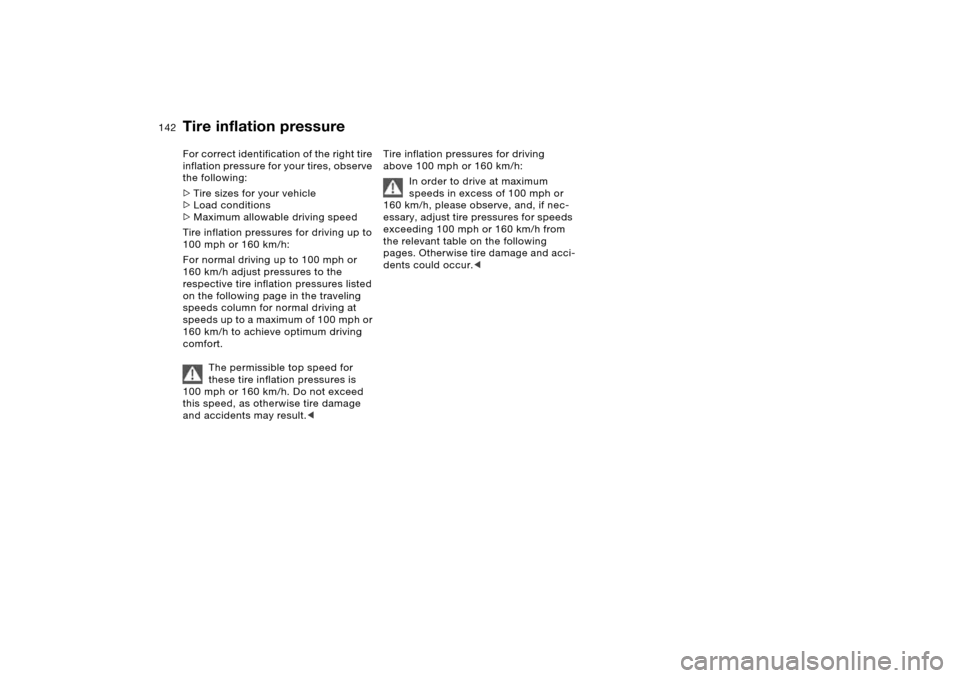
142n
Tire inflation pressureFor correct identification of the right tire
inflation pressure for your tires, observe
the following:
>Tire sizes for your vehicle
>Load conditions
>Maximum allowable driving speed
Tire inflation pressures for driving up to
100mph or 160km/h:
For normal driving up to 100 mph or
160 km/h adjust pressures to the
respective tire inflation pressures listed
on the following page in the traveling
speeds column for normal driving at
spe eds up to a m axim um o f 10 0 m p h or
160 km/h to achieve optimum driving
comfort.
The permissible top speed for
these tire inflation pressures is
100mph or 160km/h. Do not exceed
this speed, as otherwise tire damage
and accidents may result.<
Tire inflation pressures for driving
above 100 mph or 160 km/h:
In order to drive at maximum
speeds in excess of 100 mph or
160 km/h, please observe, and, if nec-
essary, adjust tire pressures for speeds
exceeding 100 mph or 160 km/h from
the relevant table on the following
pages. Otherwise tire damage and acci-
dents could occur.<
Page 143 of 202

143n
OverviewControlsMaintenanceRepairsDataIndex
Tire inflation pressureBMW Tire size Pressure specifications in psi/kPa
Traveling speeds
up to a max. of
100 mph/160 km/hTraveling speeds
including those exceeding
100 mph/160 km/h
All pressure specifications in
the table are indicated in psi/
kilopascal with cold tires,
cold = ambient temperature
X5 3.0i235/65 R 17 104 H M+S
255/55 R 18 105 H M+S32/220 33/230 32/220 32/220 32/220 39/270
Front: 255/50 R 19 103 V
Rear: 285/45 R 19 107 V
Front: 275/40 R 20 102 W
Rear: 315/35 R 20 106 W32/220
–
32/220
––
32/220
–
32/22032/220
–
32/220
––
32/220
–
32/22032/220
–
32/220
––
39/270
–
39/270
You will find more information on permissible loads and weights on page182.
Page 144 of 202
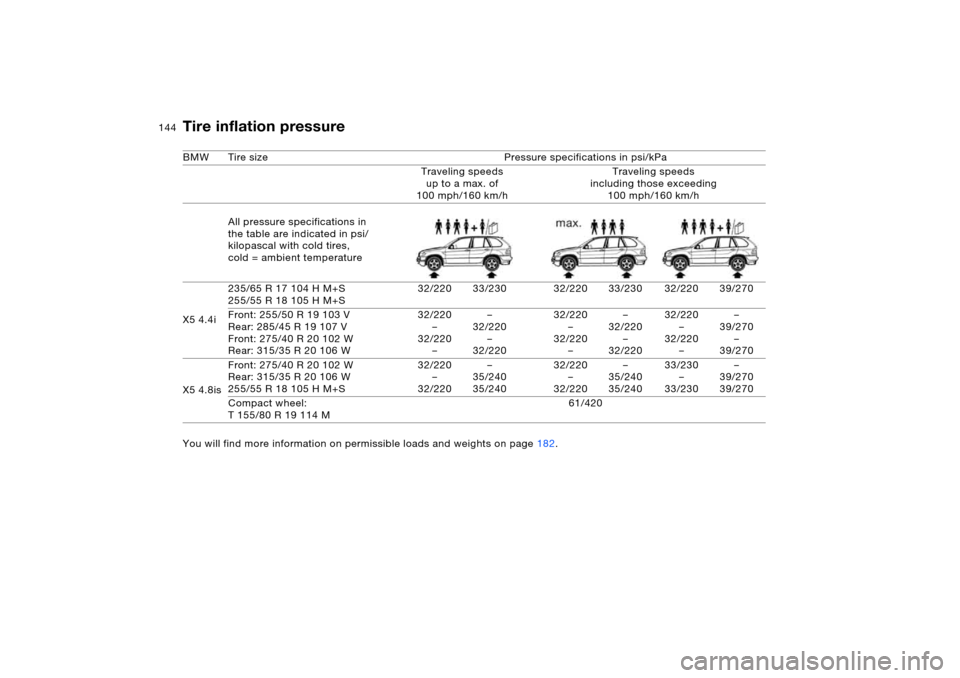
144n
Tire inflation pressureBMW Tire size Pressure specifications in psi/kPa
Traveling speeds
up to a max. of
100 mph/160 km/hTraveling speeds
including those exceeding
100 mph/160 km/h
All pressure specifications in
the table are indicated in psi/
kilopascal with cold tires,
cold = ambient temperature
X5 4.4i235/65 R 17 104 H M+S
255/55 R 18 105 H M+S32/220 33/230 32/220 33/230 32/220 39/270
Front: 255/50 R 19 103 V
Rear: 285/45 R 19 107 V
Front: 275/40 R 20 102 W
Rear: 315/35 R 20 106 W32/220
–
32/220
––
32/220
–
32/22032/220
–
32/220
––
32/220
–
32/22032/220
–
32/220
––
39/270
–
39/270
X5 4.8isFront: 275/40 R 20 102 W
Rear: 315/35 R 20 106 W
255/55 R 18 105 H M+S32/220
–
32/220–
35/240
35/24032/220
–
32/220–
35/240
35/24033/230
–
33/230–
39/270
39/270
Compact wheel:
T 155/80 R 19 114 M61/420
You will find more information on permissible loads and weights on page182.
Page 146 of 202
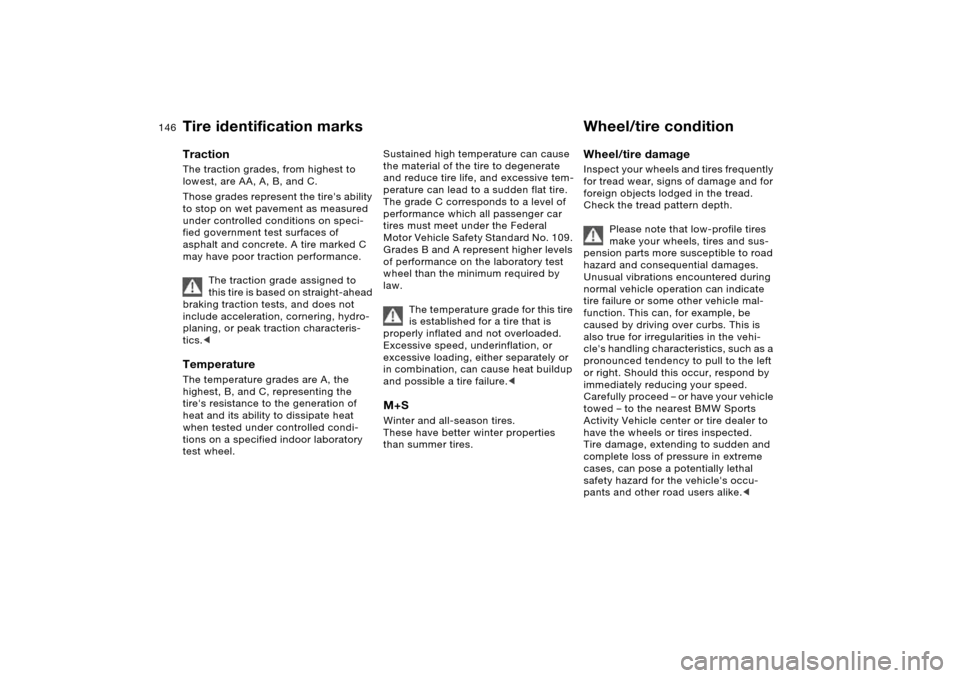
146n
Tire identification marks Wheel/tire condition Traction The traction grades, from highest to
lowest, are AA, A, B, and C.
Those grades represent the tire's ability
to stop on wet pavement as measured
under controlled conditions on speci-
fied government test surfaces of
asphalt and concrete. A tire marked C
may have poor traction performance.
The traction grade assigned to
this tire is based on straight-ahead
braking traction tests, and does not
include acceleration, cornering, hydro-
planing, or peak traction characteris-
tics.< TemperatureThe temperature grades are A, the
highest, B, and C, representing the
tire's resistance to the generation of
heat and its ability to dissipate heat
when tested under controlled condi-
tions on a specified indoor laboratory
test wheel.
Sustained high temperature can cause
the material of the tire to degenerate
and reduce tire life, and excessive tem-
perature can lead to a sudden flat tire.
The grade C corresponds to a level of
performance which all passenger car
tires must meet under the Federal
Motor Vehicle Safety Standard No. 109.
Grades B and A represent higher levels
of performance on the laboratory test
wheel than the minimum required by
law.
The temperature grade for this tire
is established for a tire that is
properly inflated and not overloaded.
Excessive speed, underinflation, or
excessive loading, either separately or
in combination, can cause heat buildup
and possible a tire failure.< M+SWinter and all-season tires.
These have better winter properties
than summer tires.
Wheel/tire damage Inspect your wheels and tires frequently
for tread wear, signs of damage and for
foreign objects lodged in the tread.
Check the tread pattern depth.
Please note that low-profile tires
make your wheels, tires and sus-
pension parts more susceptible to road
hazard and consequential damages.
Unusual vibrations encountered during
normal vehicle operation can indicate
tire failure or some other vehicle mal-
function. This can, for example, be
caused by driving over curbs. This is
also true for irregularities in the vehi-
cle's handling characteristics, such as a
pronounced tendency to pull to the left
or right. Should this occur, respond by
immediately reducing your speed.
Carefully proceed – or have your vehicle
towed – to the nearest BMW Sports
Activity Vehicle center or tire dealer to
have the wheels or tires inspected.
Tire damage, extending to sudden and
complete loss of pressure in extreme
cases, can pose a potentially lethal
safety hazard for the vehicle's occu-
pants and other road users alike.<
Page 170 of 202

170n
Changing a wheel5. Position the jack at the jacking point
closest to the flat tire so that the jack
base is vertically below the jacking
point and the entire surface of the
head of the jack will move into the
square recess of the jacking point,
refer to the illustration detail, when
the jack is cranked.
6. Jack the vehicle up until the wheel
you are changing is raised from the
ground.
7. Unscrew the lug bolts and remove
the wheel.
8. Remove accumulations of mud or dirt
from the mounting surfaces of the
wheel and hub. Clean the lug bolts.
9. Move the spare wheel into position.
Secure the wheel by turning at least
two lug bolts into opposite bolt
holes. 530de236
10. Screw in the remaining lug bolts.
Tighten all the bolts securely in a
diagonal pattern.
11. Lower the jack and remove it from
beneath the vehicle.
12. Tighten the lug bolts in a diagonal
pattern.
13. Check and correct the tire inflation
pressure at the earliest opportunity.
After mounting the spare wheel or
correcting the inflation pressure,
reinitialize the Flat Tire Monitor,
refer to page99.
Protect valve stems and valves from dirt
using screw-on valve stem caps. Dirt in
the valve stems frequently leads to slow
leaks.
The vehicle jack is designed for
changing wheels only. Do not
attempt to raise another vehicle model
with it or to raise any load of any kind.
To do so could cause accidents and
personal injury.
To ensure safety, always have the lug
bolts checked with a calibrated torque
wrench as soon as possible to ensure
that they are tightened to the specified
torque. The tightening torque is
101 lb ft/140 Nm.<
Store the wheel and the tools in the
order opposite that for removal.
Before removing the support rod,
be sure that the tailgate is held
down firmly. If you fail to do so, it could
spring upward abruptly and cause per-
sonal injury and vehicle damage.
After you remove the rod, close the tail-
gate carefully. Continue to hold it firmly
until it is completely closed.<
If light-alloy wheels other than Genuine
BMW light-alloy wheels have been
mounted, it may be necessary to use
different lug bolts for those wheels.
Replace the defective tire as soon as
possible and have the new wheel/tire
balanced. Driving with compact wheelDrive reservedly and do not exceed a
maximum speed of 50 mph/80 km/h.
Altered handling characteristics, such
as reduced track stability during brak-
ing, longer braking distances and
altered self-steering properties at the
driving limit can occur. These proper-
ties are more apparent in conjunction
with winter tires.